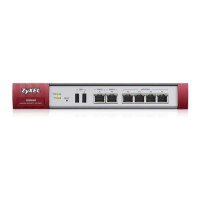ZyWALL Series CLI Reference Guide
117
CHAPTER 16
Interfaces
This chapter shows you how to use interface-related commands.
16.1 Interface Overview
In general, an interface has the following characteristics.
• An interface is a logical entity through which (layer-3) packets pass.
• An interface is bound to a physical port or another interface.
• Many interfaces can share the same physical port.
• An interface is bound to at most one zone.
• Many interfaces can belong to the same zone.
• Layer-3 virtualization (IP alias, for example) is a kind of interface.
Some characteristics do not apply to some types of interfaces.
16.1.1 Types of Interfaces
You can create several types of interfaces in each Zyxel Device model. The types supported vary by
Zyxel Device model.
• Port groups create a hardware connection between physical ports at the layer-2 (data link, MAC
address) level.
• Ethernet interfaces are the foundation for defining other interfaces and network policies. RIP and
OSPF are also configured in these interfaces.
• VLAN interfaces receive and send tagged frames. The Zyxel Device automatically adds or removes
the tags as needed. Each VLAN can only be associated with one Ethernet interface.
• Bridge interfaces create a software connection between Ethernet or VLAN interfaces at the layer-2
(data link, MAC address) level. Unlike port groups, bridge interfaces can take advantage of some
security features in the Zyxel Device. You can also assign an IP address and subnet mask to the
bridge.
• PPPoE/PPTP interfaces support Point-to-Point Protocols (PPP). ISP accounts are required for PPPoE/PPTP
interfaces.
• Cellular interfaces are for 3G WAN connections via a connected 3G device.
• Virtual interfaces (IP alias) provide additional routing information in the Zyxel Device. There are three
types: virtual Ethernet interfaces, virtual VLAN interfaces, and virtual bridge interfaces.
• VPN Tunnel Interface (VTI) encrypts or decrypts IPv4 traffic from or to the interface according to the IP
routing table.
• Link Aggregation Group (LAG) interfaces combine multiple physical Ethernet interfaces into a single
logical interface, thus increasing uplink bandwidth and availability in the event a link goes down.

